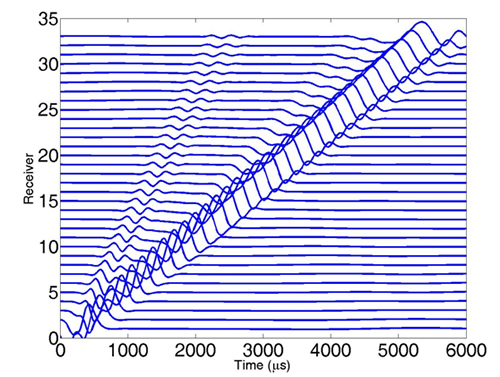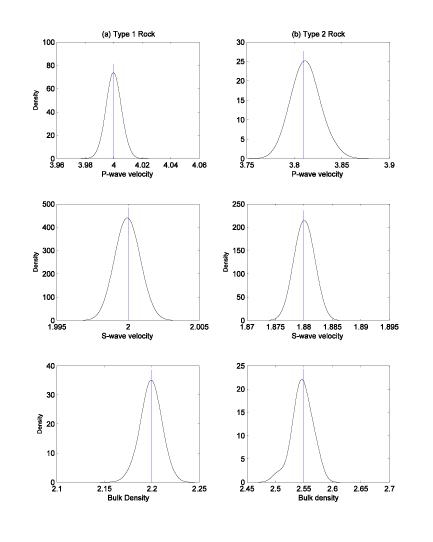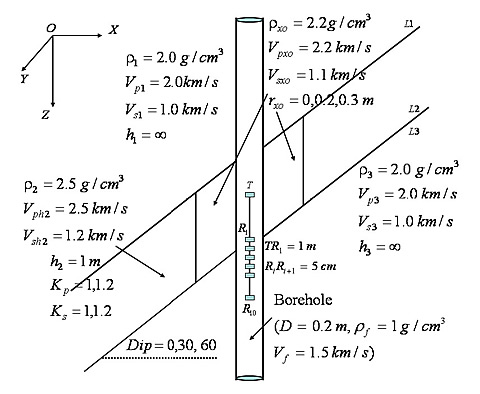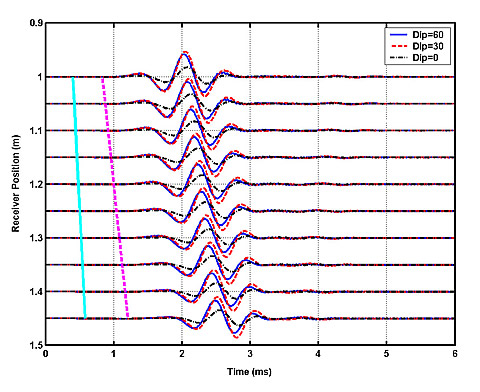Together with rock-core laboratory data, wireline and logging-while-drilling measurements remain the primary means of assessing in-situ properties of hydrocarbon-bearing rocks. However, because their length of investigation is less than 3 m, wireline logs can be biased by borehole damage and mud-filtrate invasion. New borehole measurements are needed to assess the spatial continuity and petrophysical properties of flow units to distances of tens of meters from the wellbore. Novel borehole measurements are also needed with 3-D capabilities to detect and assess reservoir flow units bypassed by wells. To date, no effort has been devoted to integrating borehole seismic and EM measurements into consistent 3-D spatial images of petrophysical properties.
Results
To date, researchers have developed:
- A 2.5-D time-domain finite-difference code to simulate borehole sonic measurements acquired in a vertical well in the presence of transversely isotropic axisymmetric distributions of elastic properties.
- A 2.5-D time-domain finite-difference code to simulate borehole sonic measurements acquired in a vertical well in the presence of axisymmetric distributions of poro-elastic properties.
- A 3-D time-domain finite-difference code to simulate borehole sonic measurements acquired in dipping wells in the presence of invaded rock formations exhibiting arbitrary elastic anisotropy.
- A 1.5-D semi-analytical elastic code to simulate borehole sonic measurements acquired in vertical wells in the presence of radially varying rock formations exhibiting TI anisotropy.
- A 1.5-D semi-analytical poro-elastic code to simulate borehole sonic measurements acquired in vertical wells in the presence of radially varying rock formations exhibiting TI anisotropy.
- Developed an inversion code to estimate radial profiles of elastic properties from full-waveform borehole acoustic measurements acquired with monopole and dipole sources and multi-receiver acquisition.
Benefits
The successful quantitative integration of borehole sonic and EM measurements will considerably improve current state-of-the-art technology to detect and assess the hydrocarbon potential of reservoir flow units undetectable with surface seismic methods. Results from this project will increase considerably the ability of oil and gas companies to detect and assess in-situ the petrophysical properties of rock formations penetrated by a borehole as well as their hydrocarbon potential. The inversion algorithms will be tested extensively and benchmarked against complex synthetic models constructed to replicate highly laminated Gulf of Mexico reservoirs, tight onshore reservoirs, dual-porosity carbonate systems, and naturally fractured formations.
Summary
The goal of this project is to develop efficient deterministic and stochastic inversion algorithms to combine borehole sonic and electromagnetic measurements in the estimation of petrophysical properties of rock formations. There are three main developments considered in this project:
- To develop efficient and accurate algorithms for the simulation of borehole EM and sonic measurements acquired in vertical and deviated wells.
- To make use of these algorithms for the independent inversion of electrical resistivity (EM) and elastic properties (sonic) of rock formations.
- To develop joint inversion algorithms that efficiently combine borehole sonic and EM measurements in the estimation of porosity, saturation, and permeability of rock formations. Both deterministic and stochastic inversion algorithms will be considered to combine the two types of measurements via empirical correlations among petrophysical, electrical, and elastic properties (e.g., Archie and Biott-Gassmann). These correlations will consider the effect of mud-filtrate invasion on sonic and electromagnetic measurements acquired in boreholes.
Thus far, researchers have accomplished the first and are currently working on the second item. The team from LBNL is working on the stochastic formulation of the combined borehole sonic-electromagnetic inversion.
Researchers currently are developing an inversion code to estimate porosity and radial profiles of saturation and elastic properties jointly from EM and full-waveform borehole acoustic measurements.








